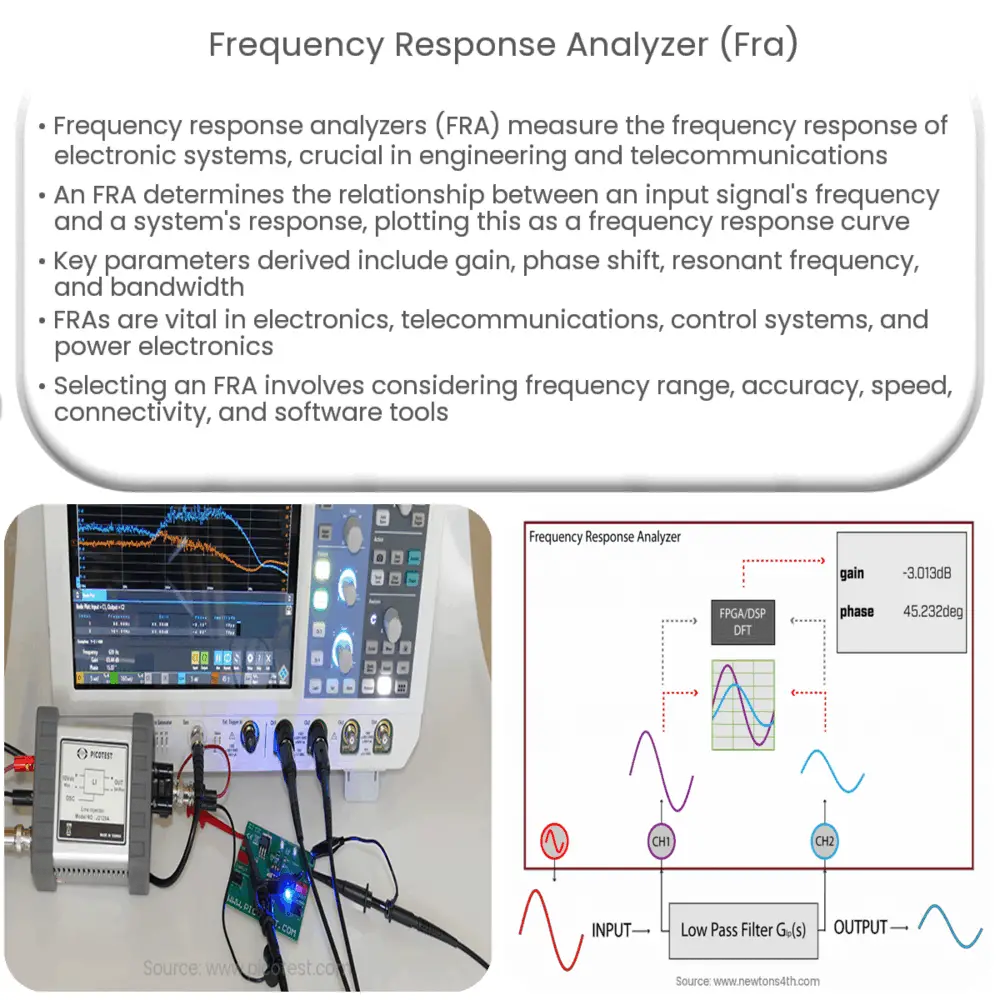A frequency response analyzer (FRA) is an electrical instrument that measures a system’s response to input signals across various frequencies, aiding in system optimization.

Introduction to Frequency Response Analyzers (FRA)
Frequency response analyzers (FRA) are advanced electrical instruments designed to measure the frequency response of various electronic systems, components, and devices. They are essential tools in the fields of engineering, telecommunications, and electronics, allowing for the analysis and optimization of system performance. In this article, we will explore the functionality of FRAs, their applications, and their importance in modern technology.
What is a Frequency Response Analyzer?
A frequency response analyzer, or FRA, is a highly specialized instrument used to measure the relationship between an input signal’s frequency and the response of a system or device to that signal. The input signal, typically a voltage or current, is applied to the system under test, and the FRA measures the output response in terms of amplitude and phase. This information is then plotted as a function of frequency, creating a frequency response plot, which provides crucial insights into the performance and behavior of the device under test.
Operating Principles of Frequency Response Analyzers
FRAs operate by generating a sinusoidal signal at a specific frequency, which is applied to the device under test. The analyzer then measures the amplitude and phase of the output signal from the device in response to the input signal. This process is repeated over a range of frequencies, generating data that can be plotted as a frequency response curve. Some of the key parameters that can be derived from this curve include:
- Gain: The ratio of output amplitude to input amplitude
- Phase shift: The difference in phase angle between the input and output signals
- Resonant frequency: The frequency at which the gain is at its maximum value
- Bandwidth: The range of frequencies over which the gain remains within a specific level
Applications of Frequency Response Analyzers
Frequency response analyzers find applications in a wide range of industries and fields, including:
- Electronics: In the design and testing of electronic components and circuits, FRAs are indispensable for characterizing the performance of filters, amplifiers, and oscillators.
- Telecommunications: FRAs are critical for analyzing the performance of communication systems, such as signal transmission and reception, and for optimizing the bandwidth and signal-to-noise ratio.
- Control Systems: In control engineering, FRAs help in the design, analysis, and optimization of feedback control systems, ensuring stability and desired performance characteristics.
- Power Electronics: The performance of power converters, such as inverters and rectifiers, can be analyzed and optimized using FRAs to ensure efficient operation and minimize losses.
Types of Frequency Response Analyzers
There are several types of frequency response analyzers available in the market, each with its own set of features and capabilities. Some of the most common types include:
- Analog FRAs: These analyzers utilize analog circuits and components to generate input signals and measure output responses. They are generally less accurate and slower than their digital counterparts but can be more cost-effective for specific applications.
- Digital FRAs: Digital frequency response analyzers use digital signal processing (DSP) techniques to generate input signals and analyze output responses. They offer higher accuracy, faster measurement times, and a wider frequency range compared to analog FRAs.
- Network analyzers: Network analyzers are versatile instruments that combine the functionality of an FRA with additional capabilities, such as measuring impedance, reflection, and transmission parameters. They are widely used in telecommunications and radio frequency (RF) engineering.
Selecting a Frequency Response Analyzer
When choosing a frequency response analyzer, there are several factors to consider, including:
- Frequency range: The frequency range of the analyzer should cover the entire range of interest for the device or system being tested.
- Accuracy: The accuracy of the FRA is crucial for ensuring reliable and consistent results. Consider the required accuracy and resolution for your specific application.
- Measurement speed: Depending on the application, a fast measurement speed may be necessary to minimize test time or capture transient behaviors.
- Interface and connectivity: Ensure that the FRA has the necessary interface options, such as USB, GPIB, or Ethernet, to integrate with your test setup and data acquisition system.
- Software and analysis tools: Some analyzers come with built-in software for data visualization and analysis, while others may require third-party software. Ensure that the analyzer is compatible with your preferred analysis tools.
Conclusion
Frequency response analyzers play a crucial role in the testing and optimization of electronic systems, components, and devices across various industries. Their ability to accurately measure the relationship between input signals and output responses provides valuable insights into the performance and behavior of the devices under test. By understanding the different types of FRAs, their operating principles, and applications, engineers and technicians can select the most suitable analyzer for their specific needs and ensure optimal performance and reliability of their systems.

